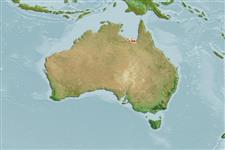Teleostei (teleosts) >
Ovalentaria/misc (Various families in series Ovalentaria) >
Pseudochromidae (Dottybacks) > Congrogadinae
Etymology: Congrogadus: Latin, conger = conger + Latin, gadus = a fish, perhaps cod (Ref. 45335); amplimaculatus: Name from the Latin 'amplus' (= large in size) and 'maculatus' (= spotted or full of spots) referring to the large number of large pale spots on the body; should be treated as a noun in apposition (Ref. 675).
More on author: Winterbottom.
Environment: milieu / climate zone / depth range / distribution range
Ecology
Marine; demersal. Tropical; 16°S - 18°S
Western Pacific: presently known only from the southern portion of the Gulf of Carpentaria.
Size / Weight / Age
Maturity: Lm ? range ? - ? cm
Max length : 12.9 cm SL male/unsexed; (Ref. 675)
Dorsal spines (total): 0; Dorsal soft rays (total): 62 - 64; Anal spines: 0; Anal soft rays: 52 - 54; Vertebrae: 66 - 69. Opercle with a dark ocellated spot. Gill membranes fused to the isthmus. Posterior otic sensory canal pore absent. Preopercular canal usually with 7 pores. Large spots arranged in three rows where dorsalmost and ventralmost rows extending distally on bases of dorsal and anal fin bases.
Feeds mainly on crustaceans. Collected from areas with substrates of sponges, sand, a little mud and few large shell fragments. Eggs with cruciform hooks on the surface.
Life cycle and mating behavior
Maturity | Reproduction | Spawning | Eggs | Fecundity | Larvae
Winterbottom, R., 1985. Revision and vicariance biogeography of the subfamily Congrogadidae (Pisces: Perciformes: Pseudochromidae). Indo-Pac. Fish. (9):34 p. (Ref. 531)
IUCN Red List Status (Ref. 130435: Version 2024-1)
Threat to humans
Harmless
Human uses
Fisheries: bycatch
Tools
Special reports
Download XML
Internet sources
Estimates based on models
Phylogenetic diversity index (Ref.
82804): PD
50 = 0.5156 [Uniqueness, from 0.5 = low to 2.0 = high].
Bayesian length-weight: a=0.00102 (0.00046 - 0.00225), b=3.06 (2.88 - 3.24), in cm total length, based on all LWR estimates for this body shape (Ref.
93245).
Trophic level (Ref.
69278): 3.5 ±0.50 se; based on food items.
Resilience (Ref.
120179): High, minimum population doubling time less than 15 months (Preliminary K or Fecundity.).
Fishing Vulnerability (Ref.
59153): Low vulnerability (10 of 100).
